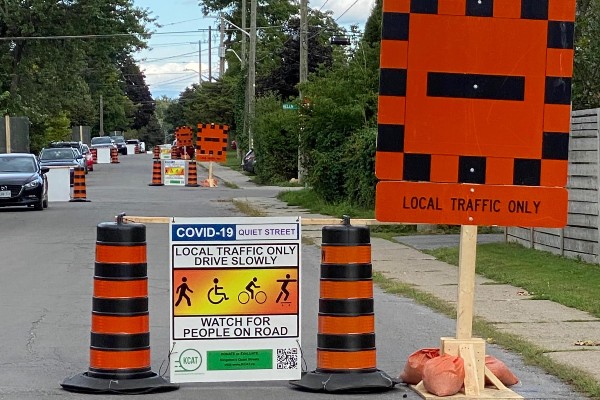Promoting active transportation during the pandemic
September 17, 2020
Share

Queen’s students and faculty often look for ways to make an impact on the Kingston community that they learn, teach, and research in. Recently, a professor and graduate student have been involved in Kingston Quiet Streets, a project led by the Kingston Coalition for Active Transportation (KCAT) that is making active transportation easier on several residential streets near campus during the COVID-19 pandemic.
“The Kingston Quiet Streets Initiative has been a great way to make a positive contribution to Kingston. It has taken months of intensive planning, but now we can see local residents taking advantage of the reduced number of cars on the quiet streets by getting out and walking, cycling, or rolling at an appropriate physical distance,” says Stephan Kukkonen, the second-year master's student in the School of Urban and Regional Planning who has been assisting with the project. “As I hope to pursue city planning after my time at Queen’s, Quiet Streets has also been a great way to get practical experience.”
The aim of Quiet Streets is to enable people using active transportation to make use of the entire roadway, not just sidewalks or the side of the street. With strategically placed signs and barriers at 44 intersections, Quiet Streets diverts motorized through traffic from select streets, asking drivers to reserve these roads for walking, cycling, and other forms of active transportation. The increased amount of available space on the streets makes it easier for people to get active outside while maintaining physical distance. All streets involved in the project remain open to the local traffic.
Kukkonen got involved in Quiet Streets through his position as a project assistant for Patricia Collins, associate professor in the School of Urban and Regional Planning. Dr. Collins and Kukkonen have worked with KCAT on all stages of the project, from identifying locations, to securing approval from the City of Kingston and setting up the signs and barriers.
“Without the help of Stephan and Dr. Collins, Quiet Streets would not have come about as quickly as it has. We hope that this pilot initiative shows the value of having streets more accessible to active transportation, and that we can continue, expand, and improve the program in the future,” says Bruce Bursey, a volunteer for KCAT. “During the pandemic, it’s more important than ever for people to have safe ways to be active outdoors.”
Early in the planning process, Kukkonen and Dr. Collins measured traffic patterns on potential streets to determine suitability. Once the pilot has been in place for several weeks, they will observe patterns again to measure the effectiveness of the program. They are also surveying both users of the Quiet Streets and residents who live on them to gauge the community’s attitudes on the pilot.
The signs and barriers went up on several Kingston streets in late August, and the pilot will run until mid-November.
Learn more about the Kingston Quiet Streets Pilot Initiative on the KCAT website.
While most university operations will still be conducted remotely throughout the fall semester, Queen’s has programs in place to promote active transportation to campus for all students, faculty, and staff. Learn more on the Sustainable Queen’s website.